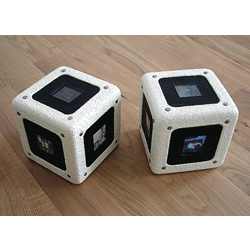
Designing new types of devices to help people recall their “cherished memories” from among all their pictures, videos, and writings was the topic of Elise van den Hoven’s keynote address “From Materialising to Memories: Design research to support personal remembering” at September’s Conference on Human-Computer Interaction 2015 (CHINZ 2015) in Hamilton, New Zealand.
Today we catalogue our lives with smartphone pictures, videos, and Facebook and Twitter timelines, but van den Hoven, a professor at the University of Technology in Sydney, Australia, says we need devices designed to display and discuss our digital records “to support human remembering by supporting our memory’s functions, [because] remembering is a reconstructive process, individual memories are subject to change, continuously, and what someone experiences as a memory does not have to be the same as what happened or what other people remember from the experience.”
Van den Hoven has been designing such hardware devices, in collaboration with psychologists, sociologists, philosophers, and like-minded designers, for years. She has come to be known in the research community for her unique approach to “materializing cherished memories.”
To Berry Eggen, adjunct professor in the Design, Architecture, and Building faculty of the University of Technology, Sydney, and a collaborator of van den Hoven, “Designers play a crucial role in how technology shapes our world. Look at how mobile technology and social media have changed our lives: for better or worse, entering ‘The Matrix’ has only just begun.”
Eggen says the digitization of media “is having its consequences on vital psychological functions in our lives. This also holds for the functions of the human autobiographical memory (AM),” which he says is “not only an important social activity for bonding and keeping relationships, but also essential for constructing and maintaining a self-identity, or for planning future actions based on past experiences.”
He explains, “For a long time, photographs and sharing photographs have been instrumental in cueing memories to support these critical human functions. A ‘tsunami’ of digital pictures flooding our daily lives might seriously endanger the effectivity of existing ways to curate and share our photo collections, and as a consequence this might affect everyday AM function in a negative way.”
The Materialising Memories design research project “comes at the right moment,” Eggen says. “It is the time to develop innovative design propositions that support people in using media like, for example, digital photographs, for maintaining these AM functions that are so all-important in daily life. Key to the design research is a deep understanding of AM and its psychological functions in our everyday lives and the translation of this knowledge into insights that are of value to designers of systems that facilitate worthwhile remembering experiences.”
Van den Hoven says the project required her and her research team to “do design research in order to try and support human remembering, and we focus on autobiographical and episodic memory, the memory types that deal with the events that you have experienced yourself, in order to ‘future-proof the past.’” She explains, “We use a people-centered design approach in which we typically first study people in everyday life and how their lives are affected by personal memories or remembering activities, and then we use that information to invent and build new interactive products, often using digital media the people create or collect themselves.”
The results include two hardware devices that she says present memory “cues” in interactive systems specifically structured to “materialize memories”: the Cueb system, made up of two cubes, each containing personal digital photos of a family member, and 4 Photos, designed to be the centerpiece of a dinner table and containing digital photo collections from dinner guests’ Facebook accounts.

The 4 Photos system.
Credit: University of Technology, Sydney, Australia
It is crucial, van den Hoven stresses, that digital cues be embedded in an interactive hardware system that makes best use of them by including a social element that focuses on certain types of memories, which become cherish-able digital objects that, in turn, can be made to “future-proof the past” and maintain a consistent AM.
Cueb, for instance, provides the scaffolding for autobiographical memories, which are facilitated through the display of random digital photographs on four cubic surfaces, which then can be discussed with friends and family. A second family member then shakes his or her Cueb, and discusses their results.
“A lot of the research on human remembering is very much focused on cognition (it’s all in the head), and external cognition is still debated in psychology/philosophy,” says van den Hoven. “However, in my field (human-computer interaction/interactive design), there’s more and more evidence that things in our environments actually have an influence on internal cognition. For example, memory cues can be external.”
Says van den Hoven, “What we are doing is supporting human remembering’s functions, which include a social function–building and maintaining social bonds with others; a self-representative function–creating a sense of identity; and a directive function–solving problems and making decisions.”
R. Colin Johnson is a Kyoto Prize Fellow who has worked as a technology journalist for two decades.



Join the Discussion (0)
Become a Member or Sign In to Post a Comment